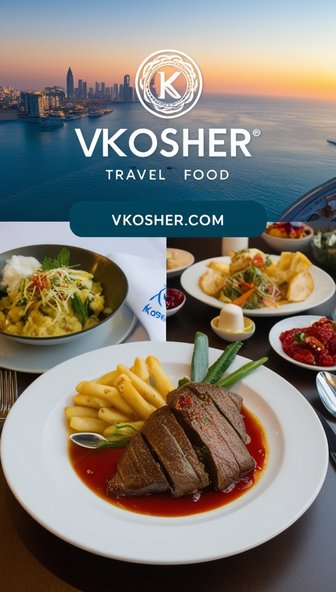Understanding Kosher Lamb: What You Need to Know
Kosher dietary laws, rooted in Jewish tradition, dictate the standards for what foods are considered acceptable for consumption. These laws are detailed and precise, encompassing not only the types of animals that can be eaten but also the methods by which they are slaughtered and prepared. One common question that arises within these dietary restrictions is whether lamb can be considered kosher. To answer this question, it's essential to explore both the general principles of kosher laws and the specific considerations related to lamb.
The Basics of Kosher Laws
Kosher laws, known as Kashrut, are a set of Jewish dietary regulations derived from the Torah. These laws are meticulously outlined in the books of Leviticus and Deuteronomy. For meat to be considered kosher, it must come from an animal that meets specific criteria. First and foremost, the animal must have cloven hooves and chew its cud. This means that animals like cows, sheep, and goats are kosher, while pigs and camels are not. Lamb, therefore, qualifies in terms of physical characteristics because it has cloven hooves and chews its cud.
Slaughtering Process: Shechita
Even if the lamb meets the basic criteria for being a kosher animal, it must also undergo a specific slaughtering process known as Shechita. This process is designed to ensure that the meat is as humane and clean as possible. Shechita requires that the animal be slaughtered by a trained individual, known as a Shochet, who uses a very sharp knife to make a swift and precise cut to the animal's throat. This cut must sever the trachea and esophagus while ensuring that the blood is properly drained from the carcass.
The Shechita process is crucial because it affects the overall quality and cleanliness of the meat. If the slaughtering is not performed according to these stringent guidelines, the meat may not be deemed kosher, even if the animal itself is otherwise acceptable. Additionally, any signs of disease or imperfections in the lamb would render the meat non-kosher, reflecting the importance of both the animal's health and the method of slaughter.
Post-Slaughter Considerations
After the lamb is slaughtered, it undergoes a series of checks and preparations to ensure its kosher status. This includes a thorough examination of the internal organs, particularly the lungs, for any signs of disease or imperfections. This step, known as Bedika, is vital for confirming that the meat is fit for consumption.
Additionally, kosher meat must be salted to remove any residual blood, as consuming blood is forbidden under kosher laws. The salting process involves covering the meat with coarse salt and allowing it to sit for a period of time before rinsing it thoroughly. This step is crucial for ensuring that the meat complies with kosher dietary restrictions.
Cooking and Handling Kosher Meat
Once the lamb has been slaughtered and prepared according to kosher laws, it must be handled and cooked in a manner consistent with kosher principles. This includes avoiding cross-contamination with non-kosher foods and using separate utensils and cookware for meat and dairy products. These practices are part of a broader set of kosher kitchen rules designed to maintain the integrity of kosher food.
Furthermore, kosher laws dictate specific guidelines for cooking meat, such as ensuring that it is cooked at the correct temperature and for the appropriate length of time. These guidelines help maintain the quality and compliance of the meat with kosher standards.
Common Misconceptions
Despite the clear guidelines provided by kosher laws, there are several common misconceptions about kosher lamb. One of the most frequent misunderstandings is that the kosher certification is a simple matter of labeling, whereas it actually involves a complex process of inspection and preparation. Many people assume that if lamb is labeled as kosher, it automatically meets all the necessary requirements, but this is not always the case. It is important to verify that the lamb has been processed and handled according to kosher standards, which often involves looking for certification from a reliable authority.
Another misconception is related to the notion that all lamb is kosher as long as it comes from an animal with cloven hooves and that chews its cud. While these are the basic criteria, the kosher status of lamb also hinges on the proper execution of Shechita and subsequent handling practices. Without adherence to these detailed requirements, the lamb cannot be deemed kosher.
The Role of Kosher Certification Agencies
To ensure that lamb and other foods meet kosher standards, many people rely on certification agencies. These agencies are responsible for inspecting and certifying that food products and preparation processes adhere to kosher laws. Their role is critical in maintaining the integrity of kosher food and providing consumers with the assurance that their food meets the required standards.
Certification agencies often conduct regular inspections of slaughterhouses, processing facilities, and even restaurants to ensure compliance with kosher laws. They also provide guidance and education to help both consumers and food producers understand and adhere to kosher practices.
The Importance of Kosher Lamb in Jewish Cuisine
Kosher lamb holds a significant place in Jewish cuisine, particularly in traditional dishes and festive meals. It is often featured in recipes for holidays such as Passover and Rosh Hashanah, where its preparation and consumption are deeply embedded in cultural and religious practices. The process of preparing kosher lamb is not only about adhering to dietary laws but also about preserving the rich culinary traditions of the Jewish community.
In many Jewish households, kosher lamb is a symbol of heritage and faith. Its preparation and consumption are approached with a sense of reverence and care, reflecting the importance of maintaining kosher standards in everyday life. For those observing kosher dietary laws, the availability and quality of kosher lamb are crucial in upholding these traditions and enjoying meals that align with their values.
Conclusion
Determining whether lamb is kosher involves a comprehensive understanding of Jewish dietary laws and the specific requirements for meat preparation. While lamb itself meets the basic criteria for kosher animals, its kosher status depends on the adherence to Shechita, the proper handling and preparation processes, and ongoing certification from reliable agencies. For those who follow kosher laws, the process of ensuring that lamb is kosher is an essential aspect of maintaining their dietary practices and cultural traditions.




